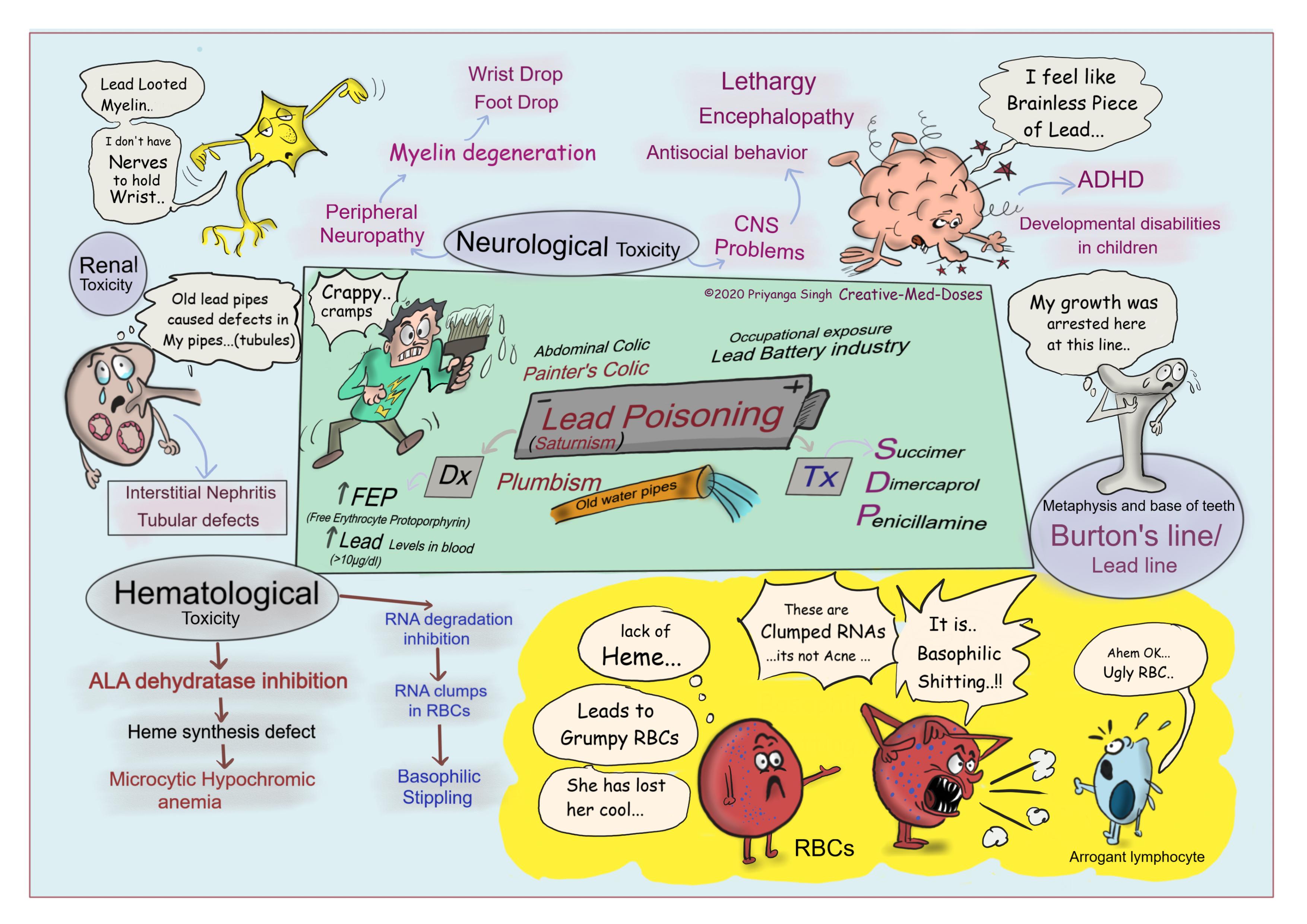Lead poisoning: Plumbism/ Saturnism
Lead poisoning is most significant preventable causes of neurologic morbidity from an environmental toxin. Lead is ubiquitous in our environment, and human exposure occurs most commonly in lead related occupations. It is also called Plumbism because of its relation to old lead pipes plumbing in old houses. Lead based painting, pottery, arm industry and toy industry workers are at Increased risk of lead poisoning. Children are very sensitive for lead poisoning because it affects their developing brain and IQ.
Pathogenesis
The major mechanism of lead toxicity is due to increased generation of reactive oxygen species and interference with antioxidant production. Lead causes the generation of hydroperoxide, hydrogen peroxide, and singlet oxygen. Free radical injury causes cell death and organ dysfunctions.
Lead blocks the activity of 5-aminolevulinic acid dehydratase (ALA dehydratase) and leads to hemoglobin oxidation, which along with the lipid peroxidation can result in red cell hemolysis. lead inhibits key enzymes in heme synthesis pathway and ↓ heme synthesis. Reduced heme leads to microcytic, hypochromic anemia.
It also inhibits rRNA degradation and RBCs retain clumps of rRNA which leads to basophilic stippling.
The effects of lead poisoning on the brain include delayed or reversed development, permanent learning disabilities, seizures, coma, and even death.
Clinical presentation
Most common affected organs systems are – nervous system, hematopoietic system, GIT, kidneys and bones
Neurological system- it is most vulnerable to lead toxicity. The manifestations in children include temperamental lability, irritability, behavioral changes, hyperactivity or decreased activity, loss of developmental milestones and language delay. Lower IQ and ADHD like symptoms may be present. Severe toxicity can cause delirium, convulsions and encephalopathy. Depression and anxiety are more common in Adult patients. Neuropsychiatric problems, impaired cognition, learning difficulties, and antisocial behavior are described in both children and adults.Lead causes demyelination of the peripheral nervous system, it may result in wrist and foot drop.
Hematological system- microcytic hypochromic anemia.
Gastrointestinal system-Patients may develop lead colic, nausea, vomiting and anorexia.
Renal system- Chronic lead nephropathy is characterized histologically by chronic interstitial nephritis and tubular defects.
Bones and teeth-Lead can interfere with bone development, leading to the formation of lead lines at bone metaphysis. These lines represent periods of growth arrest and called Burton's lines, or lead lines. They are also found on gingival tissue at base of the teeth
Reproductive system- In males, it causes reductions in sperm count and fertility. In females, it increases the risk of spontaneous abortions, stillbirths, and preterm births.
...

...
Diagnosis
- Clinical presentation and history of lead exposure
- ↑ level of free erythrocyte protoporphyrin (FEP)
- ↑ lead level (> 10 μg/dL) on venous sampling
- Peripheral blood smear- hypochromic microcytic RBCs and basophilic stippling
- Radiograph showing Burton's lines, or lead lines on long bone metaphysis
Treatment
- Chelation therapy- Succimer is initial drug of choice and penicillamine is second line drug, both are oral agents.
- Severe cases or lead encephalopathy- parenteral dimercaprol plus EDTA are given in combination, dimercaprol can cross blood brain barrier hence very useful in encephalopathy.
Revision for today https://creativemeddoses.com/topics-list/organophosphate-poisoning/
Further reading https://www.ncbi.nlm.nih.gov/pmc/articles/PMC5044910/
Buy fun review books here (these are kindle eBook’s you can download kindle on any digital device and login with Amazon accounts to read them). Have fun and please leave review. https://creativemeddoses.com/books/
Please subscribe and share. 😍😎